NATO Air Commander (NAC) is a new solitaire game by Hollandspiele, set during a hypothetical World War III between NATO and the Warsaw Pact in Germany that focuses on the air war. Players slip into the role of the air component commander and have to allocate air assets in order to facilitate NATO winning the war.
This is the fourth post in a multi-post series on NATO Air Commander and the relationship between air and land power. For the other posts see:
- NATO Air Commander – The Wargame
- Unboxing NATO Air Commander
- The Role of Air Power in Warfare (a conceptual overview of the role of airpower and a review of the book The Air Campaign by John Warden III, head planner of the air campaign in the First Gulf War)
- Rules Overview of NATO Air Commander (the post you are reading now)
- First Game AAR of NATO Air Commander
This post will provide a little summary of the rules.
Components
There are four important components in NAC:
- Air unit counters
- Ground force counters
- Resolution cards
- Objective cards
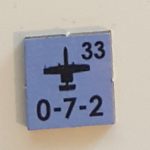
Each air unit counter represents a wing. Each air unit has the following stats:
- Air rating: air-to-air combat ability
- Ground rating: combat effectiveness against ground targets, think CAS
- Strike rating: combat effectiveness against specific ground targets, think SEAD
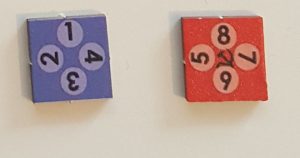
Ground force counters represent ground units. Each ground unit has a cohesion value, which is an overall rating of its size, coordination, and command. The ratings range from 1 (lowest) to 8 (highest).
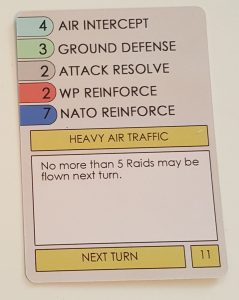
Resolution cards are used instead of dice in order to get an element of randomness into the game. Different values are used depending on what type of role is necessary.
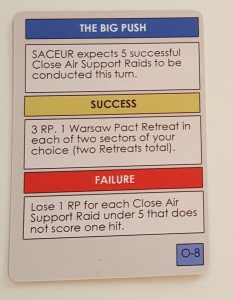
Objective cards represent requests from ground commanders for support. Fulfilling them has positive, not fulfilling them negative effects for the air component commander.
Phases
The game is divided into nine phases:
- Receive Objective Phase
- Recon Phase
- Air Planning Phase
- Raid Resolution Phase
- Ground Combat Phase
- Reinforcement Phase
- Events Phase
- Resource Points Phase
- Turn End Phase
During the Receive Objective Phase, the player pulls two objective cards from the deck. Then, during the Recon Phase, the player can decide if he wants to invest air assets for battlefield surveillance, to locate HQs (in order to specifically target them in a later phase), or locate staging areas (so reinforcements can be attacked at a later phase).
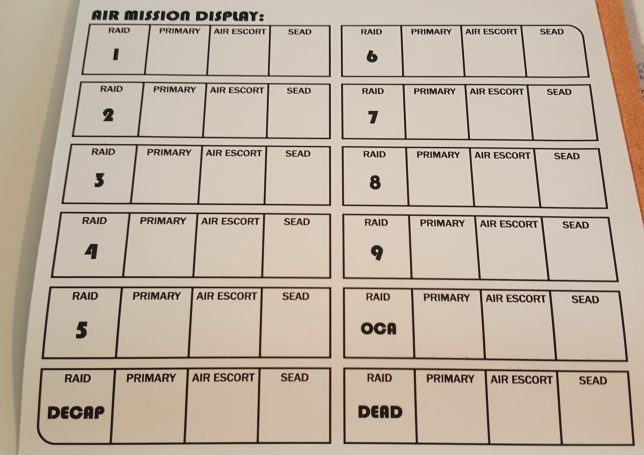
Planning and organizing your force into raids and assigning them to missions happens during the Air Planning Phase. There are five primary missions:
- CAS: direct support to a NATO ground force
- Follow-On Forces Attack: an attack on Warsaw Pact reinforcements (have to be already located in the Recon Phase)
- Destruction of Enemy Air Defenses (DEAD): specifically targeting ground-based air defenses
- Offensive Counter-Air: offensive action in order to debilitate enemy air capabilities
- Decapitating Strike: attack enemy HQs that have already been located during the Recon Phase
These planned raids are resolved one-by-one during the Raid Resolution Phase. The sequence of resolution is important, as effects from prior raids directly influence subsequent raids. Each raid is resolved by first going through an Air Interception Segment (air-to-air combat), Ground Defense Segment (enemy ground-based air defense systems try to attack the player’s raid) and then the Primary Mission Results Segment.
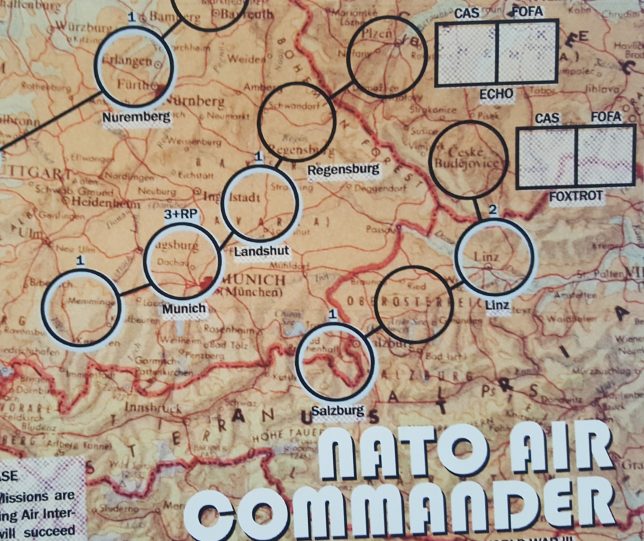
Ground combat is resolved during the Ground Combat Phase. As ground combat is highly abstract, this happens quickly with the help of resolution cards. Reinforcements arrive during the Reinforcements Phase, where only one NATO unit, but all Warsaw Pact units are reinforced, simulating the sheer overwhelming materiel and personnel superiority of the Soviets. Then, during the Events Phase, a resolution card is drawn and the event described on it is resolved.
End of turn tidying up and assignment of various points and resources happens during the Resource Point Phase and Turn End Phase.
Conclusion
NATO Air Commander’s rules were refreshing to read and the game was fun to learn. It is nice to see this level of simplification and abstraction in a genre that is dominated by thick rulebooks and complicated rules. I really liked reading and learning the rules!
Have you played NATO Air Commander? What do you think of the rules? Share your thoughts in the comments!